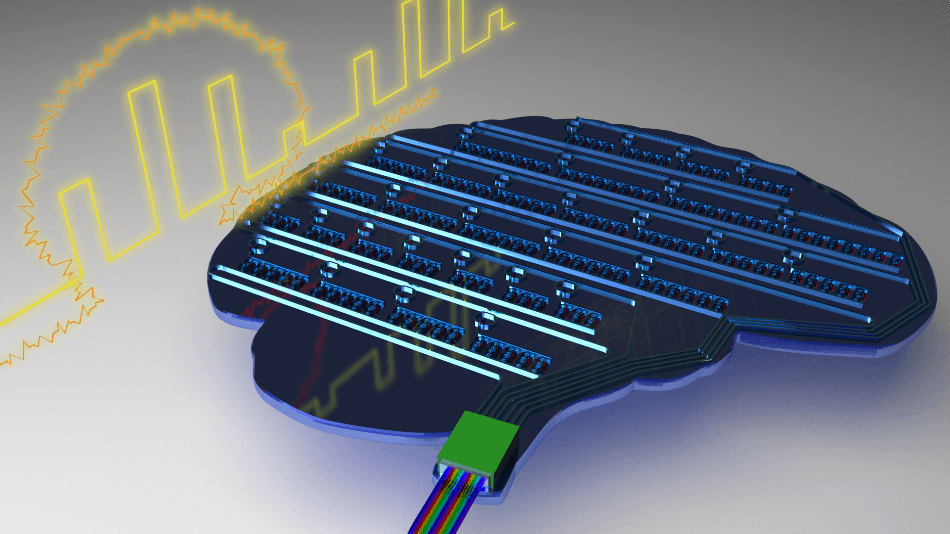May 9 2019
A technology that works like a brain! In this era of artificial intelligence, this does not seem so incredible anymore—for instance, when a mobile phone can distinguish languages or faces.
 Schematic illustration of a light-based, brain-inspired chip. By mimicking biological neuronal systems, photonic neuromorphic processors provide a promising platform to tackle challenges in machine learning and pattern recognition. (Image credit: Johannes Feldmann)
Schematic illustration of a light-based, brain-inspired chip. By mimicking biological neuronal systems, photonic neuromorphic processors provide a promising platform to tackle challenges in machine learning and pattern recognition. (Image credit: Johannes Feldmann)
However, with more intricate applications, computers still rapidly encounter their own drawbacks. One of the reasons for this is that a computer usually has separate memory and processor units due to which all data must be transmitted back and forth between the two. In this aspect, the human brain is far advanced than even the most up-to-date computers as it processes and stores information in the same region, that is, in the synapses, or links between neurons and a million-billion of them are present in the brain.
An international research group from the Universities of Münster (Germany), Oxford and Exeter (both UK) has now successfully developed a piece of hardware which could open the door for developing computers that function like the human brain. The researchers managed to create a chip comprising of a network of artificial neurons that works with light and can mimic the behavior of neurons and their synapses.
The scientists could show that such an optical neurosynaptic network can “learn” information and use this as a foundation for computing and identifying patterns—just like how a brain does. Since the system functions only with light and not with conventional electrons, it is able to process data many times faster.
This integrated photonic system is an experimental milestone. The approach could be used later in many different fields for evaluating patterns in large quantities of data, for example in medical diagnoses.
Prof. Wolfram Pernice, Study Lead Partner, Münster University
The research is reported in the most recent issue of the Nature journal.
The Story in Detail—Background and Method Used
A majority of the current approaches pertaining to so-called neuromorphic networks are based on electronics, while optical systems—in which photons, i.e. light particles, are employed—are still in their early stage. The principle that is now presented by the German and British researchers works as follows.
First, optical waveguides that can send light and can be fabricated into optical microchips are built into the so-called phase-change materials, which are already found nowadays on storage media like re-writable DVDs. These phase-change materials are distinguished by the fact that they change their optical properties noticeably, on the basis of whether they are crystalline—when their atoms assemble themselves in a regular fashion—or amorphous—when their atoms arrange themselves randomly. This phase change can be stimulated by light if a laser increases the temperature of the material.
Because the material reacts so strongly, and changes its properties dramatically, it is highly suitable for imitating synapses and the transfer of impulses between two neurons,
Johannes Feldmann, Study Lead Author, Münster University
Feldmann also conducted many of the experiments as part of his PhD thesis at the Münster University.
In their work, the researchers, for the first time, succeeded in combining several nanostructured phase-change materials into a single neurosynaptic network. A chip with four artificial neurons and a total of 60 synapses was created by the researchers. The structure of the chip—having various layers—was developed on the basis of the so-called wavelength division multiplex technology, which is a process in which light is passed through various channels within the optical nanocircuit.
To investigate the extent to which the system can identify patterns, the scientists “fed” information in the form of light pulses to the system using two distinct machine-learning algorithms. During this process, an artificial system would “learn” from examples and will eventually generalize them. Regarding the two algorithms used—both in so-called supervised and unsupervised learning—the artificial network could eventually identify a pattern being requested based on the given light patterns—one of which was four consecutive letters.
“Our system has enabled us to take an important step towards creating computer hardware which behaves similarly to neurons and synapses in the brain and which is also able to work on real-world tasks,” says Wolfram Pernice. “By working with photons instead of electrons we can exploit to the full the known potential of optical technologies—not only in order to transfer data, as has been the case so far, but also in order to process and store them in one place,” adds co-author Prof. Harish Bhaskaran from the University of Oxford.
One particular example is the use of such hardware to automatically identify cancer cells. However, more work will be required before such applications could become a reality. The scientists must raise the number of artificial neurons and synapses and increase the depth of neural networks. This can be achieved, for instance, using optical chips produced with the help of silicon technology. “This step is to be taken in the EU joint project “Fun-COMP” by using foundry processing for the production of nanochips,” stated Prof. C. David Wright from the University of Exeter, who is a co-author and leader of the Fun-COMP project.
Funding
This joint study was funded by Germany’s DFG (grant PE 1832/5-1), the United Kingdom’s EPSRC (grants EP/J018694/1, EP/M015173/1, and EP/M015130/1), and the European Commission’s ERC (grant 724707) and H2020 (the Fun-COMP project, grant 780848) programmes.